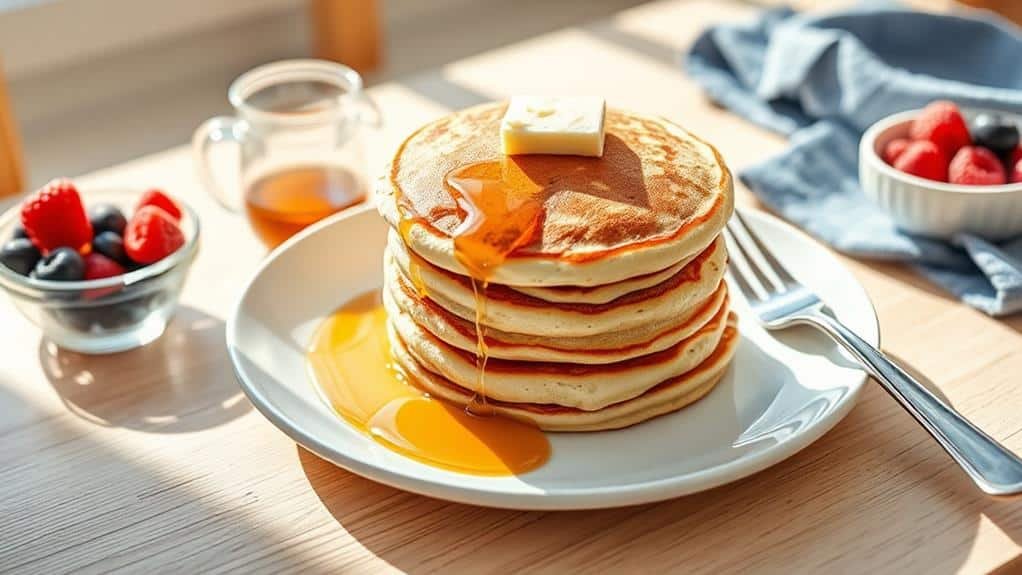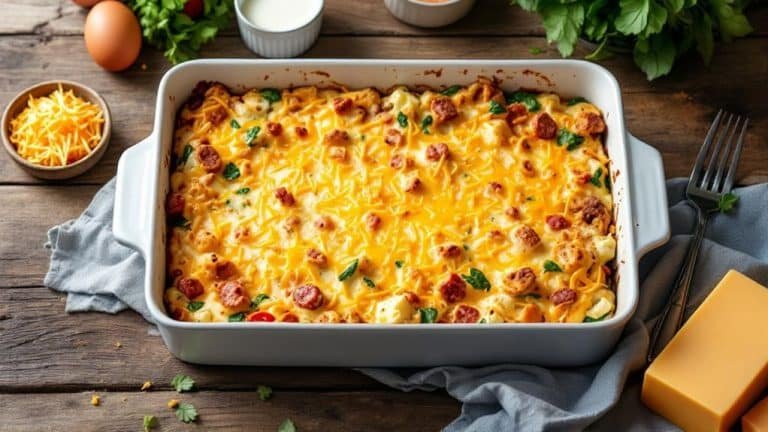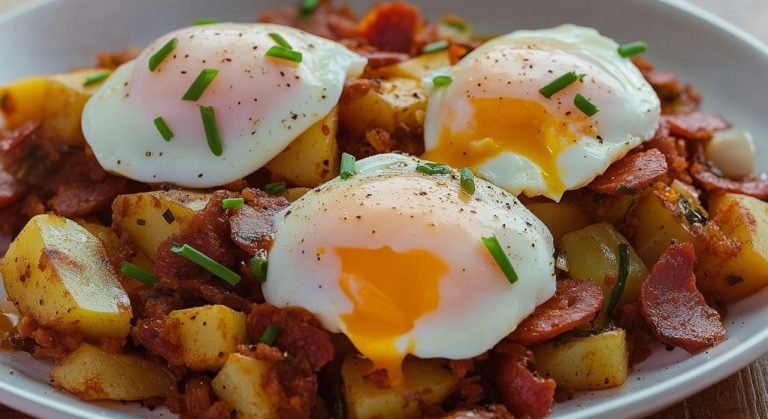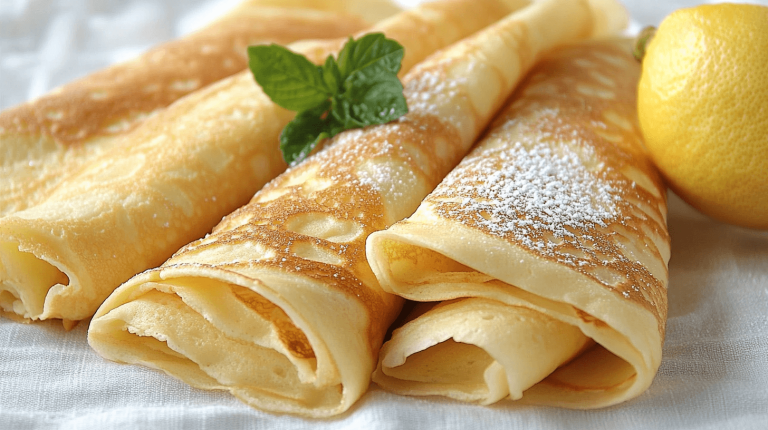You’ll love these quick and easy pancakes that have been enjoyed for centuries. With just five basic ingredients, you’ll create fluffy, golden discs of comfort in no time. Mix your dry ingredients, whisk in the wet ones, and gently combine for a smooth batter. Pour 1/4 cup portions onto a preheated skillet, watching for bubbles to form before flipping. In just minutes, you’ll have a stack of tender, lightly sweet pancakes ready for your favorite toppings. Whether you’re a beginner or a seasoned cook, these pancakes will bring warmth and joy to your breakfast table. Discover the secrets to perfecting this beloved dish and making it your own.
Key Takeaways
- Use a simple recipe with just five basic ingredients: flour, baking powder, sugar, egg, and milk.
- Mix dry and wet ingredients separately, then combine gently to avoid overmixing the batter.
- Pour 1/4 cup of batter per pancake onto a preheated, non-stick skillet or griddle.
- Flip pancakes once bubbles form on the surface and edges appear dry.
- Cook for 1-2 minutes on each side until golden-brown, adjusting heat as needed for even cooking.
History
For centuries, pancakes have been a beloved breakfast staple around the world. You’ll find that these flat, circular cakes have evolved from simple grain and water mixtures to the fluffy, golden delights we enjoy today.
In ancient Greece, you’d have encountered ‘tagenites,’ thin wheat pancakes served with honey and cheese. As you explore further, you’ll discover that medieval Europeans often ate pancakes during Shrove Tuesday, using up rich ingredients before the fasting period of Lent.
When you investigate American pancake history, you’ll learn that Native Americans were making cornmeal pancakes long before European settlers arrived. As you follow the pancake’s journey through time, you’ll see how it became a symbol of comfort and hospitality in many cultures.
In the 19th century, you’d have found pancakes becoming increasingly popular in American households, thanks to the availability of chemical leavening agents like baking soda. Today, as you whip up a batch of quick pancakes, you’re participating in a culinary tradition that spans millennia, connecting you to countless cooks who’ve shared in this simple, satisfying art.
Recipe
Quick and Easy Pancakes
These simple pancakes are perfect for those mornings when you want a delicious breakfast without the fuss. Using just five basic ingredients, you can whip up a batch of fluffy, golden pancakes in no time. This recipe is ideal for beginners or anyone looking for a quick and satisfying meal.
Despite its simplicity, this pancake recipe yields light and tasty results that rival more complex versions. The pancakes have a tender texture and subtle sweetness that pairs well with a variety of toppings. Whether you prefer them with classic maple syrup or dressed up with fresh fruits and whipped cream, these pancakes are sure to please.
- 1 cup all-purpose flour
- 2 teaspoons baking powder
- 1/2 teaspoon salt
- 2 tablespoons sugar (optional)
- 1 cup milk
- 1 large egg
- 2 tablespoons unsalted butter
In a large mixing bowl, combine the flour, baking powder, and sugar. In a separate bowl, whisk together the milk and egg. Pour the wet ingredients into the dry ingredients and mix until just combined, being careful not to overmix.
Heat a non-stick skillet or griddle over medium heat. Pour about 1/4 cup of batter for each pancake onto the heated surface. Cook until bubbles form on the surface, then flip and cook for an additional 1-2 minutes until golden brown. Serve immediately with your favorite toppings.
For best results, avoid overmixing the batter, as this can lead to tough pancakes. If the batter seems too thick, add a little more milk to achieve the desired consistency. To keep pancakes warm while cooking the entire batch, place them on a baking sheet in a 200°F (95°C) oven. For added flavor, consider incorporating mix-ins like blueberries, chocolate chips, or banana slices directly into the batter before cooking.
Cooking Steps
To make these quick pancakes, you’ll follow a simple series of steps that’ll have you flipping golden discs in no time.
First, you’ll mix your dry ingredients in one bowl and whisk the wet ingredients in another, then combine them gently to create your batter.
Once your skillet or griddle is heated to medium, you’ll pour about 1/4 cup of batter for each pancake, cooking until bubbles form on top before flipping to achieve that perfect golden-brown color on both sides.
Step 1. Mix Dry Ingredients Together
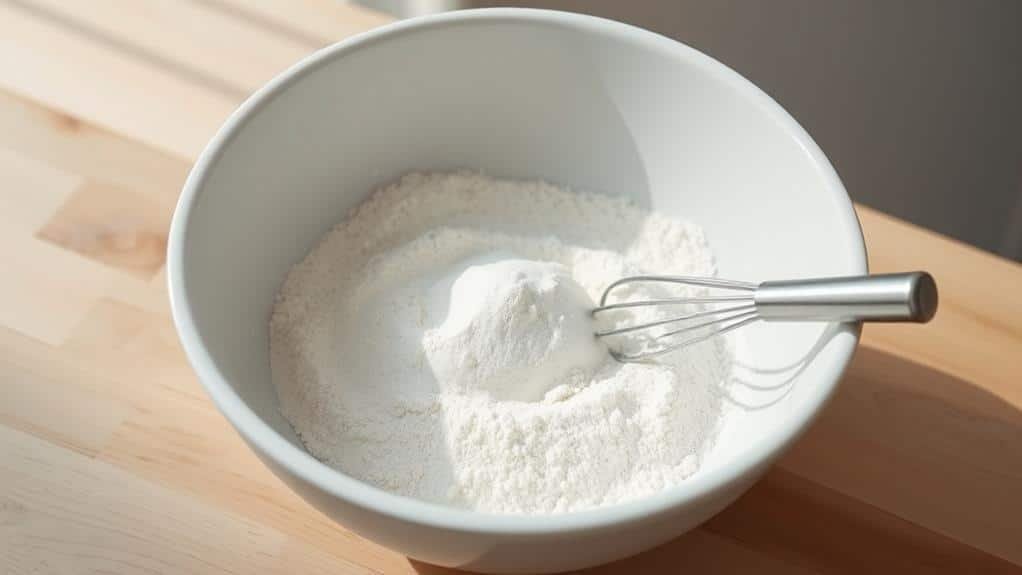
The foundation of your quick pancakes begins with the dry ingredients. In a large mixing bowl, you’ll combine the all-purpose flour, salt, baking powder, and sugar, which form the base of your pancake batter. As you measure out each ingredient, take care to level off your measuring cups and spoons for accuracy, ensuring the perfect balance of flavors and textures in your final product.
The flour, a staple in pancake recipes for centuries, provides structure to your pancakes, while the baking powder, a modern leavening agent, gives them their characteristic fluffiness. Sugar, though used sparingly, adds a subtle sweetness that enhances the overall taste profile.
Once you’ve measured out your dry ingredients, use a whisk or fork to thoroughly combine them, breaking up any lumps in the flour and evenly distributing the baking powder and sugar. This step is vital for achieving a smooth, consistent batter that will cook evenly on the griddle.
As you mix, imagine the delightful aroma of freshly cooked pancakes that will soon fill your kitchen, bringing joy to those you’re serving.
Step 2. Whisk Wet Ingredients Separately
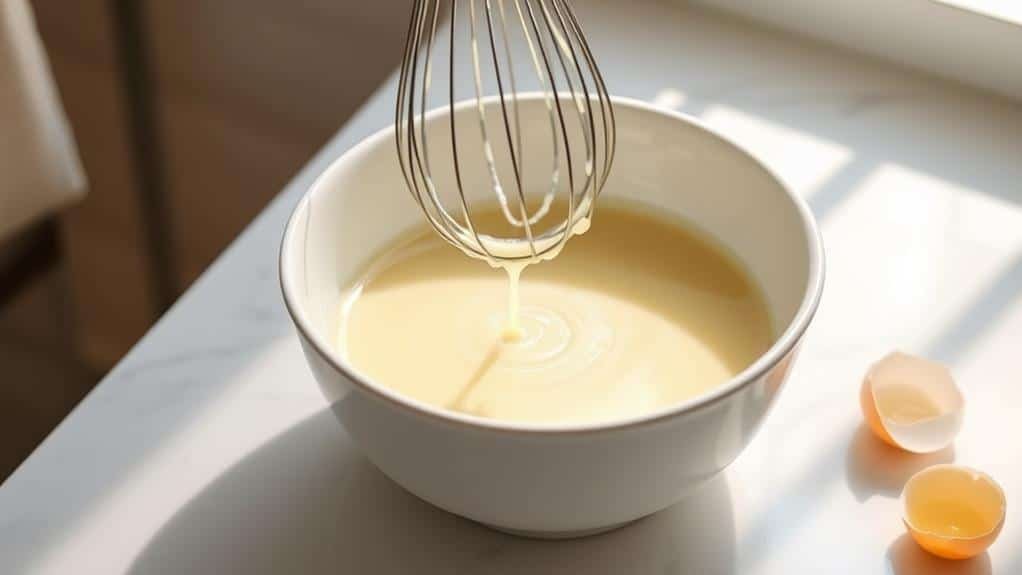
In a separate bowl, you’ll prepare the wet ingredients for your quick pancakes. Crack a large egg into the bowl, making certain no shell fragments fall in. The egg will provide structure and richness to your pancakes, aiding them in rising and achieving that perfect fluffy texture.
Next, measure out one cup of milk and pour it into the bowl with the egg. You can use any type of milk you prefer, whether it’s whole, low-fat, or even a non-dairy alternative like almond or oat milk. The milk will add moisture and help create a smooth batter.
Now, it’s time to whisk these wet ingredients together. Using a fork or a wire whisk, beat the egg and milk vigorously until they’re well combined. You’ll notice the mixture becoming frothy and slightly lighter in color as you whisk. This process incorporates air into the wet ingredients, which will contribute to the lightness of your pancakes.
Continue whisking for about 30 seconds to make sure everything is thoroughly blended and ready to be combined with the dry ingredients.
Step 3. Combine Wet and Dry Ingredients
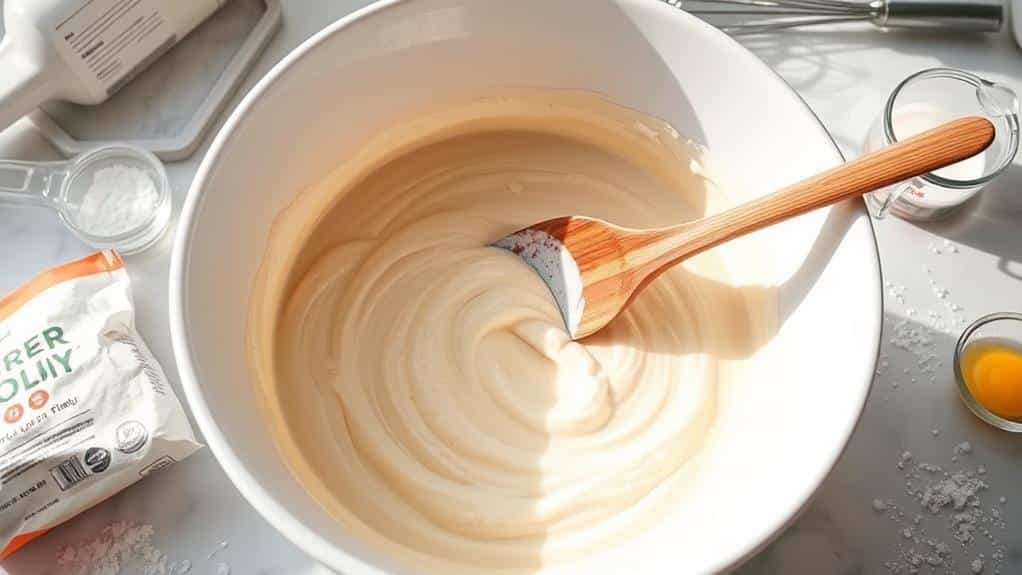
With your wet and dry ingredients prepared separately, it’s time to bring them together. This essential step in pancake-making will determine the texture of your final product, so it’s important to approach it with care. Pour the whisked milk and egg mixture into the bowl containing your flour, baking powder, and sugar. As you combine these ingredients, you’ll be creating a batter that’s been enjoyed for centuries, with pancakes dating back to ancient civilizations.
Using a spatula or wooden spoon, gently fold the wet ingredients into the dry ones. Be mindful not to overmix; a few lumps in your batter are perfectly fine and will contribute to the fluffiness of your pancakes.
As you stir, you’ll notice the batter becoming smooth and silky, with a consistency similar to thick cream. If it seems too thick, don’t hesitate to add a splash more milk. Remember, the perfect pancake batter should slowly drip off your spoon, not pour like water or stick stubbornly.
Once combined, let the batter rest for a few minutes to allow the ingredients to meld together, ensuring a light and airy texture in your finished pancakes.
Step 4. Heat Skillet or Griddle
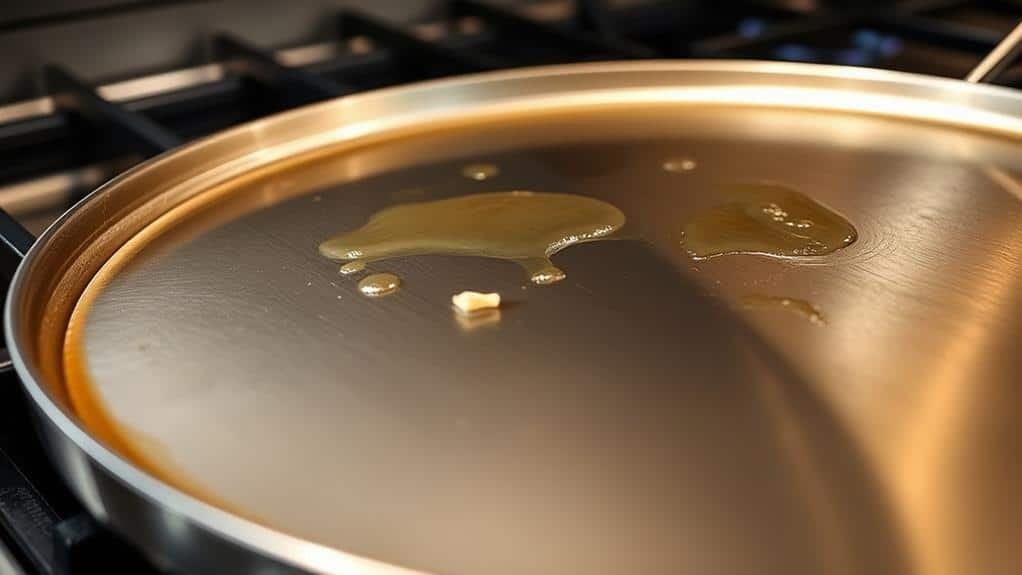
Preparing your cooking surface is essential for perfect pancakes. You’ll want to heat your skillet or griddle over medium heat, allowing it to warm up gradually for even cooking.
If you’re using a non-stick pan, you won’t need to add any oil or butter, but if you’re working with a cast-iron skillet, a light coating of oil will help prevent sticking.
As you wait for your cooking surface to reach the ideal temperature, which should take about 3-5 minutes, you can test its readiness by sprinkling a few drops of water onto the surface. If the water droplets sizzle and dance across the pan, you’ll know it’s hot enough to start cooking your pancakes.
Remember, patience is key here; if your pan is too hot, your pancakes will burn on the outside while remaining raw in the middle. On the other hand, if it’s not hot enough, your pancakes will absorb too much oil and become greasy.
Finding that perfect balance will guarantee your pancakes turn out golden-brown and delicious, ready to be served to your enthusiastic breakfast companions.
Step 5. Pour Batter and Cook
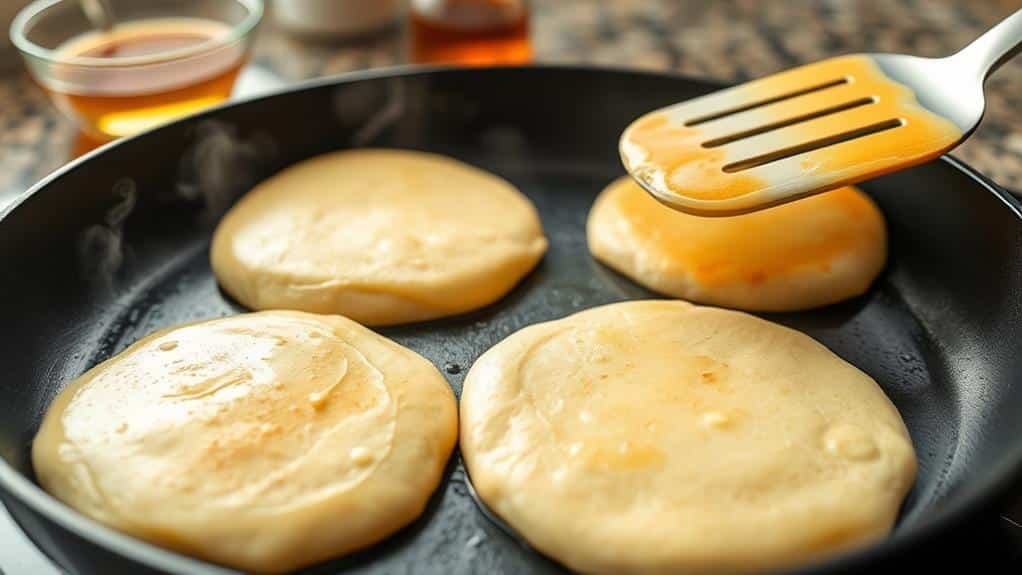
The moment of truth has arrived: it’s time to pour your batter and watch your pancakes come to life. With your skillet or griddle preheated to medium, you’re ready to create golden, fluffy discs of breakfast perfection. Using a ladle or measuring cup, pour about 1/4 cup of batter onto the hot surface for each pancake, leaving enough space between them for easy flipping.
As the batter spreads and settles, you’ll notice tiny bubbles forming on the surface, a telltale sign that it’s time to flip. Once you see these bubbles popping and the edges starting to look dry, it’s your cue to gently slide your spatula underneath and, with a swift motion, flip the pancake over. The second side will cook faster, usually taking only 1-2 minutes to achieve that perfect golden-brown color.
As you continue cooking, you’ll develop a rhythm, pouring and flipping with the confidence of a seasoned chef. Remember, the first pancake is often a test run, so don’t be discouraged if it’s not picture-perfect. Each subsequent pancake will be better as you fine-tune your technique.
Final Thoughts
Simplicity reigns supreme in this quick pancake recipe. You’ll find that with just five basic ingredients, you can create a delicious breakfast that’ll satisfy your whole family. As you whip up these pancakes, remember that the key to fluffy, golden-brown perfection lies in the mixing technique and cooking process. Don’t be afraid to experiment with different toppings or mix-ins to personalize your pancakes and make them even more special for those you’re serving.
To guarantee your pancakes turn out perfectly every time, keep these tips in mind:
- Avoid overmixing the batter to prevent tough pancakes
- Adjust the batter consistency with a little extra milk if needed
- Use a preheated, non-stick surface for even cooking
- Flip the pancakes only once to maintain their light texture
As you serve these quick pancakes, take pride in knowing that you’ve created a comforting meal with minimal effort. The aroma of freshly cooked pancakes will fill your kitchen, bringing warmth and joy to your morning routine. Whether you’re cooking for your family or hosting a brunch, these pancakes are sure to impress and nourish those you care about.
Frequently Asked Questions
Can I Substitute Whole Wheat Flour for All-Purpose Flour?
You can certainly use nature’s wholesome alternative in place of the usual flour. While it may alter the texture slightly, you’ll be nourishing others with a heartier option. Adjust the liquid if needed to achieve the perfect pancake consistency.
How Long Can I Store Leftover Pancake Batter in the Refrigerator?
You can store leftover pancake batter in the refrigerator for up to 2 days. Make sure you cover it tightly with plastic wrap or transfer it to an airtight container. Give it a quick stir before using it again.
What’s the Best Way to Reheat Leftover Pancakes?
Like a golden sun rising, your pancakes can shine again. You’ll serve them best by reheating in a toaster for crispy edges. For softer results, warm them in the microwave, covered with a damp paper towel. Enjoy serving!
Can I Make These Pancakes Without Eggs?
You can make these pancakes without eggs! Try substituting the egg with a mashed banana or 1/4 cup of applesauce. These alternatives will help bind the ingredients and add moisture, ensuring you’ll still enjoy delicious, fluffy pancakes for your loved ones.
How Do I Prevent My Pancakes From Sticking to the Pan?
To prevent sticking, guarantee you’re using a non-stick pan or griddle. Lightly grease the surface with butter or oil before each batch. Don’t flip too early; wait for bubbles to form. You’ll serve perfect, non-stick pancakes every time!

